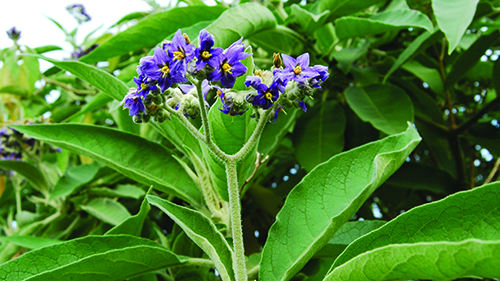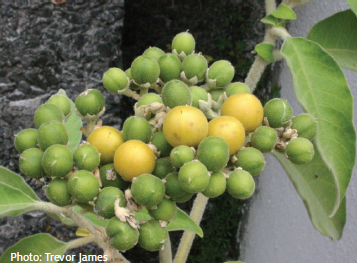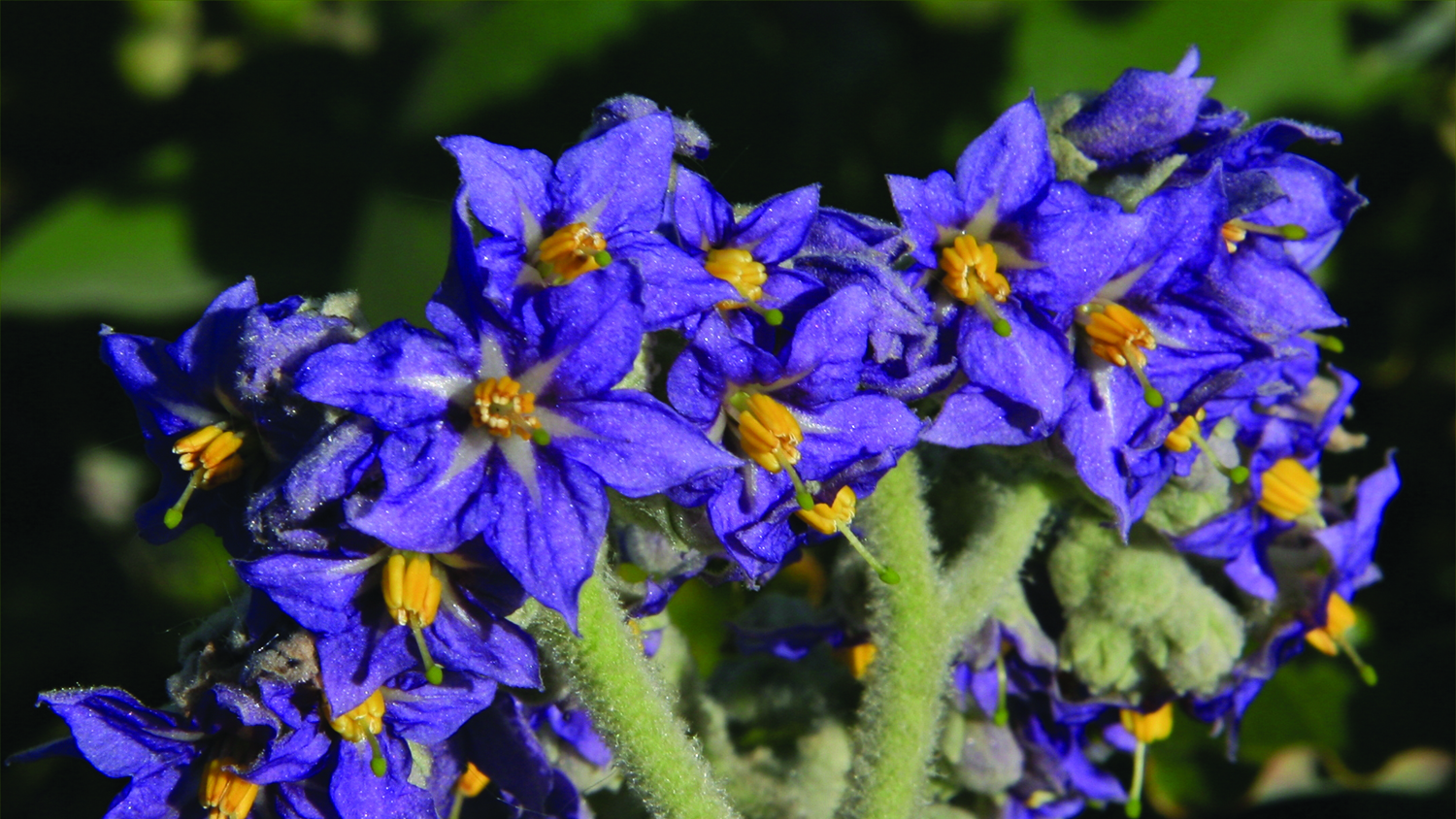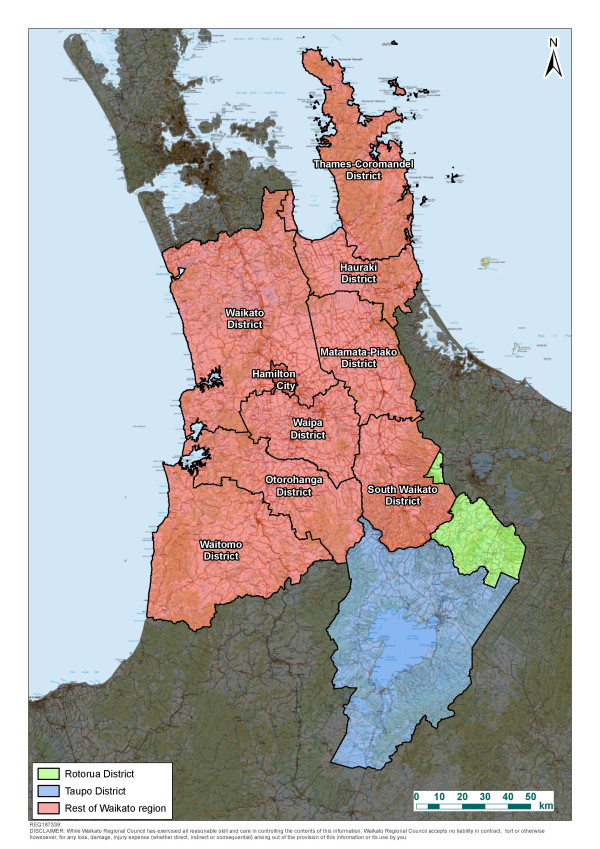| Management programme |
|
Progressive containment (Taupō and Rotorua districts within the Waikato region) Sustained control (excluding Taupō and Rotorua districts) |
| Objectives |
|
Within the Taupō and Rotorua districts: Reduce the amount of woolly nightshade and the number of locations that have it Rest of the Waikato: Reduce the effects of velvetleaf on land free of or being cleared of it elsewhere in the Waikato region. |
| Impacts |
| Economic, biodiversity, human health, social and cultural wellbeing, amenity/recreation, animal welfare |
Woolly nightshade, native to South America, was originally introduced to New Zealand as a garden plant, but by the 1880s it had spread into the wild. It is now widespread in parts of Northland, Auckland, Bay of Plenty and parts of the Waikato region. Woolly nightshade is a problem where it forms dense stands that crowd out and inhibit the establishment and growth of other plants. It invades pastoral land, native wetland and forest margins, scrublands, and urban areas.

What does it look like?
Woolly nightshade is a spreading shrub or small tree up to 10m in height with a trunk up to 20cm in diameter.
Flower
- Each flower (1.5cm-2cm across) has five mauve to purple petals with a yellow centre.
- Flowers grow in clusters (panicles) at the end of the branches.
- Flowers all year round.
Fruit/seed
- Berries are round (1cm diameter) initially green, ripening to yellow.
- Each berry contains many small seeds (1mm-2mm long).
- Most berries are produced in late spring to summer.
Leaves/stems
- Leaves (10cm-25cm long) are grey green, oval shaped and densely covered with furry hairs.
- Leaves have a strong kerosene-like smell, especially when rubbed or crushed.
Why is it a pest?
Woolly nightshade a rapidly growing shrub or tree. In large numbers it can rapidly invade poorly managed land and forest margins, totally excluding the regeneration of native plants. Dense stands can invade pasture on poor soils, especially in hill country, and impede livestock movement.
Fine hairs on its leaves and stems, that are shed when brushed or touched, can also be an irritant to some people and cause respiratory problems. The berries of woolly nightshade are moderately toxic to people (especially children), and they may be poisonous to livestock.
A single woolly nightshade plant can produce many thousands of seeds, which are spread by birds. These seeds can lie dormant in the soil and germinate up to 20-30 years later.
Woolly nightshade is now well established in many areas of the Waikato region north of Taupō (it is relatively frost intolerant). Within the Taupō and Rotorua districts, woolly nightshade has a limited distribution, however, where it occurs it may have significant impacts. For this reason, Waikato Regional Council will undertake control of woolly nightshade on all private, rateable land within the Taupō and Rotorua districts in the Waikato region. Outside these parts of the region, where woolly nightshade may be more widespread, occupiers are responsible for its control within 50m of any shared boundary where the adjacent or nearby occupiers are undertaking control of it.
How can I control woolly nightshade?
Taupō and Rotorua district (within the Waikato region):
Waikato Regional Council is responsible for controlling woolly nightshade in the Taupō and Rotorua districts (within the Waikato region) and it is illegal for anyone else to remove or disturb it there. If you see woolly nightshade on your property in this part of the region, do not cut, treat or try to remove it. Call 0800 800 401 to report it to your local biosecurity pest plant officer.
Landowners/occupiers in the Waikato outside Taupō and Rotorua districts may control woolly nightshade as follows.
Physical control
Small plants (less than 60cm) can be pulled out and left to dry after shaking all dirt from the roots. Larger plants that are cut down need to have the stump treated with herbicide or they will regrow. Try not to disturb the soil.
Herbicide control
Cut stump treatment
Cut the tree down, leaving a stump no higher than 5cm above ground level. Immediately (within two minutes of cutting) paint herbicide over the entire stump surface, including the sides.
Drill and inject
Drill 10mm holes around the trunk at a 45 degree angle, 50mm deep and 50mm apart. Fill each hole with herbicide.
Stem frilling
To control larger trees, make shallow downward cuts around the trunk below the lowest branch and near the ground using a machete or axe. Cuts should overlap to effectively ringbark the tree. Apply herbicide liberally to each cut.
Basal treatment of trunk
Using a specific basal treatment herbicide* liberally paint or spray the trunk from the ground to a height of 30cm to 50cm, making sure to cover the entire trunk. *Talk to your local herbicide retailer for more information.
Spray application
Totally cover the leaf surfaces with herbicide. This method is most suitable for smaller plants, but pulling out plants by hand may be cheaper and easier.
Safety when using herbicides
- Follow the instructions on the manufacturer’s label.
- Always wear protective clothing.
- Always minimise the risk to your other plants.
- Contact the supplier for further advice.
Summary of herbicides and application methods for control
| Herbicide | Application |
| Glyphosate | Drill and inject, stump swabbing, stem frilling (Note: Glyphosate is NOT suitable for overall spraying). |
| Amitrole | Drill and inject, stump swabbing, stem frilling, spray application. |
| Triclopyr | Stump swabbing, drill and inject, stem frilling, trunk base treatment. |
| Picloram gel | Stump swabbing. |
| Triclopyr/picloram mix | Drill and inject, stump swabbing, stem frilling, spray application. |
| Herbicide rules will apply. You may need to notify neighbours if spraying. The Waikato Regional Plan explains the agrichemical (herbicides) use rule in section 6.2. | |
| If applying herbicide over water, a resource consent may be required. Please check with Waikato Regional Council before you begin. | |

Management
After initial control, it is important to:
- check the site again at least annually to control any new seedlings and/or regrowth
- stop weeds invading the site by replanting with non-pest plants (preferably native plants) once the pest plant is no longer a problem.
More information
Advice
- For advice and additional information on control methods, call our pest plant staff on freephone 0800 800 401.
- Chemical company representatives, farm supply stores, garden centres or the Weedbusters website can also be good sources for advice.
Publications
- The following publications are available for download or from Waikato Regional Council. Contact us to request a copy (freephone 0800 800 401).





